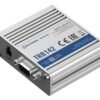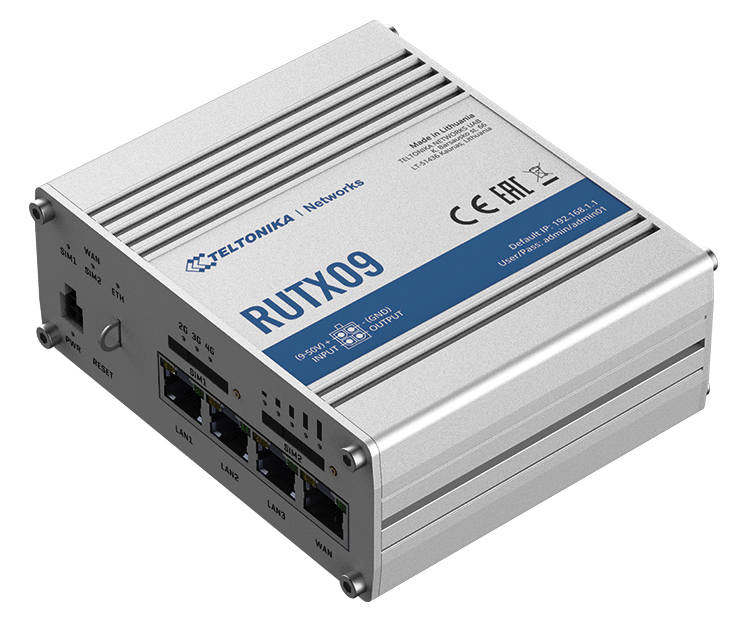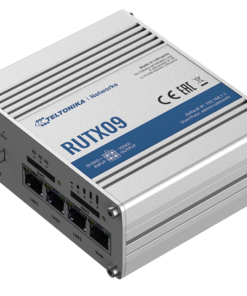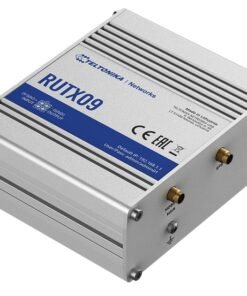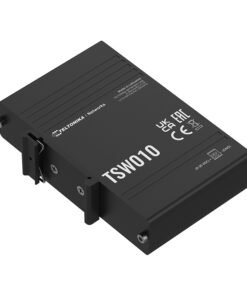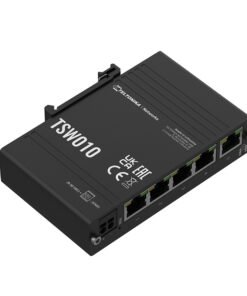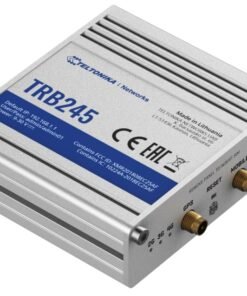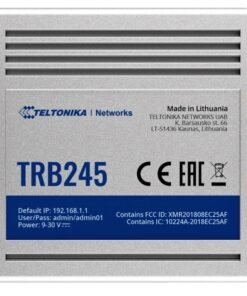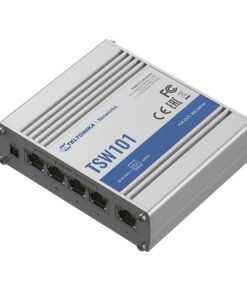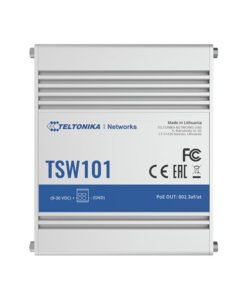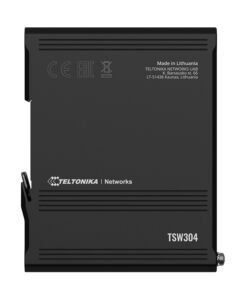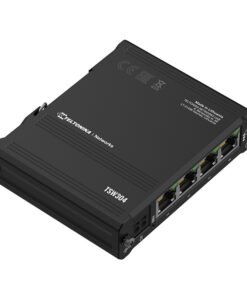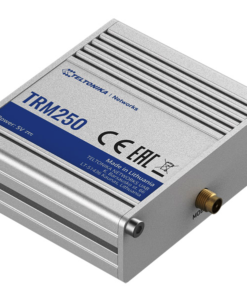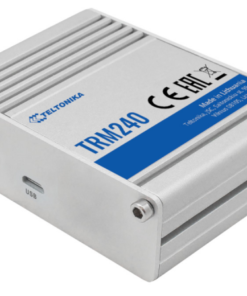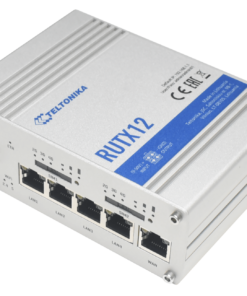RUTX09 Industrial Router 4G LTE CAT 6, Dual Sim Gigabit Ethernet
€292.00 excl VAT
This RUTX09 Industrial Router is designed to serve as a main/backup Internet source when a consistent, high-throughput connection is required. It is equipped with :
- Dual SIM and 4x Gigabit Ethernet connections.
- Advanced RutOS software and security features.
- Global Navigation Satellite System
- 4G Cellular speeds up to 300Mbps
Teltonika RUTX09 Industial Cellular Router with Ethernet and I/O, Dual SIM and Advanced VPN
Teltonika RUTX09 Industrial Router is the best option if you’re looking for a user-friendly, secure router with a robust Open Wireless router-based operating system and slots for two SIM cards! The setup is fast and simple to control. It is quick, simple, and reliable.
RUTX09 is made of contemporary design and provides a variety of the best truly new features. They are the ones who have advanced in terms of functionality.
When a reliable connection and high data throughput are needed, the Teltonika RUTX09 is the answer. It is a robust industrial LTE-Advanced Cat6 cellular IoT router intended to serve as either the primary or backup Internet source.
RUTX09 Industrial Router Key Features:
Take a peek at the hippest mobile router with the best modern features and purchase one.
- The RUTX09 is an all-time bestseller industrial cellular router that supports LTE Cat 6 data rates of up to 300 Mbps.
- Dual-SIM with auto Failover, Backup WAN, and other SW features guarantees that, in the event of any connectivity issues, a backup connection will be automatically switched to.
- Numerous secure VPN services that are widely used, with reliable 24/7 operation
- Gigabit Ethernet can reach 1000 Mbps in speed.
- With the choice of DIN rail mounting, an extremely durable aluminum house casing
- connection watchdog
- Wide variety of voltages (9-50 V)
- There are many security features accessible for maximum safety, including Advanced firewall functionality, IPsec, SNMP, and Content Filtering.
- Provides a higher data rate per subscriber.
- 3 alternative internet sources
- Various techniques for encryption
- Wi-Fi dual band
Note: For best cellular operation, external antennae are advised.
MOBILE
-
Mobile module: 4G (LTE) – Cat 6 up to 300 Mbps, 3G – Up to 42 Mbps
-
SIM switch: 2 SIM cards, auto-switch cases: weak signal, data limit, SMS limit, roaming, no network, network denied, data connection fail, SIM idle protection
-
Status: Signal strength (RSSI), SINR, RSRP, RSRQ, EC/IO, RSCP, Bytes sent/received, connected band, IMSI, ICCID, Carrier aggregation
-
SMS: SMS status, SMS configuration, send/read SMS via HTTP POST/GET, EMAIL to SMS, SMS to EMAIL, SMS to HTTP, SMS to SMS, scheduled SMS, SMS autoreply, SMPP
-
USSD: Supports sending and reading Unstructured Supplementary Service Data messages
-
Black/White list: Operator black/white list
-
Multiple PDN: Possibility to use different PDNs for multiple network access and services
-
Band management: Band lock, Used band status display
-
APN: Auto APN
-
Bridge: Direct connection (bridge) between mobile ISP and device on LAN
-
Pass-through: Router assigns its mobile WAN IP address to another device on LAN
ETHERNET
-
WAN: 1 x WAN port 10/100/1000 Mbps, compliance with IEEE 802.3, IEEE 802.3u, 802.3az standards, supports auto MDI/MDIX crossover
-
LAN: 3 x LAN ports, 10/100/1000 Mbps, compliance with IEEE 802.3, IEEE 802.3u, 802.3az standards, supports auto MDI/MDIX crossover
-
Routing: Static routing, Dynamic routing (BGP, OSPF v2, RIP v1/v2, NHRP)
-
Network protocols: TCP, UDP, IPv4, IPv6, ICMP, NTP, DNS, HTTP, HTTPS, FTP, SMTP, SSL v3, TLS, ARP, VRRP, PPP, PPPoE, UPNP, SSH, DHCP, Telnet, SMPP, SMNP, MQTT, Wake On Lan (WOL)
-
VoIP pass through support: H.323 and SIP-alg protocol NAT helpers, allowing proper routing of VoIP packets
-
Connection monitoring: Ping Reboot, Wget Reboot, Periodic Reboot, LCP and ICMP for link inspection
-
Firewall: Port forward, traffic rules, custom rules
-
DHCP: Static and dynamic IP allocation, DHCP Relay, Relayd
-
QoS / Smart Queue Management (SQM): Traffic priority queuing by source/destination, service, protocol or port, WMM, 802.11e
-
DDNS: Supported >25 service providers, others can be configured manually
-
Network backup: WiFi WAN, Mobile, VRRP, Wired options, each of which can be used as an automatic Failover
-
Load balancing: Balance Internet traffic over multiple WAN connections
-
SSHFS: Possibility to mount remote file system via SSH protocol
SECURITY
-
Authentication: Pre-shared key, digital certificates, X.509 certificates
-
Firewall: Pre-configured firewall rules can be enabled via WebUI, unlimited firewall configuration via CLI; DMZ; NAT; NAT-T
-
Attack prevention: DDOS prevention (SYN flood protection, SSH attack prevention, HTTP/HTTPS attack prevention), port scan prevention (SYN-FIN, SYN-RST, X-mas, NULL flags, FIN scan attacks)
-
VLAN: Port and tag based VLAN separation
-
Mobile quota control: Custom data limits for both SIM cards
-
WEB filter: Blacklist for blocking out unwanted websites, Whitelist for specifying allowed sites only
-
Access control: Flexible access control of TCP, UDP, ICMP packets, MAC address filter
-
OpenVPN: Multiple clients and a server can run simultaneously, 12 encryption methods
-
OpenVPN Encryption: DES-CBC, RC2-CBC, DES-EDE-CBC, DES-EDE3-CBC, DESX-CBC, BF-CBC, RC2-40-CBC, CAST5-CBC, RC2-64-CBC, AES-128-CBC, AES-192-CBC, AES-256-CBC
-
IPsec: IKEv1, IKEv2, with 5 encryption methods for IPsec (DES, 3DES, AES128, AES192, AES256)
-
GRE: GRE tunnel
-
PPTP, L2TP: Client/Server instances can run simultaneously, L2TPv3 support
-
Stunnel: Proxy designed to add TLS encryption functionality to existing clients and servers without any changes in the program’s code
-
DMVPN: Method of building scalable IPsec VPNs
-
SSTP: SSTP client instance support
-
Zero Tier :ZeroTier VPN client support
-
Wire Guard: WireGuard VPN client and server support
-
ID range: Respond to one ID in range [1;255] or any
-
Allow Remote Access: Allow access through WAN
-
Custom registers: MODBUS TCP custom register block requests, which read/write to a file inside the router, and can be used to extend MODBUS TCP Slave functionality
-
Supported functions: 01, 02, 03, 04, 05, 06, 15, 16
-
Supported data formats: 8 bit: INT, UINT; 16 bit: INT, UINT (MSB or LSB first); 32 bit: float, INT, UINT (ABCD (big-endian), DCBA (little-endian), CDAB, BADC)
-
Protocol: HTTP(S), MQTT, Azure MQTT
-
MQTT Gateway: Allows sending commands and receiving data from MODBUS Master through MQTT broker
-
Supported modes: TCP Master, DNP3 Outstation
-
WEB UI: HTTP/HTTPS, status, configuration, FW update, CLI, troubleshoot, event log, system log, kernel log
-
FOTA: Firmware update from server, automatic notification
-
SSH: SSH (v1, v2): SMS, SMS status, SMS configuration, send/read SMS via HTTP POST/GET
-
Call: Reboot, Status, Mobile data on/off, Output on/off, answer/hang-up with a timer, WiFi on/off
-
TR-069: OpenACS, EasyCwmp, ACSLite, tGem, LibreACS, GenieACS, FreeACS, LibCWMP, Friendly tech, AVSystem
-
MQTT: MQTT Broker, MQTT publisher
-
SNMP: SNMP (v1, v2, v3), SNMP Trap
-
JSON-RPC: Management API over HTTP/HTTPS
-
MODBUS: MODBUS TCP status/control
-
RMS: Teltonika Remote Management System (RMS)
IOT PLATFORMS
-
Cloud of Things: Allows monitoring of: Device data, Mobile data, Network info, Availability
-
ThingWorx: Allows monitoring of: WAN Type, WAN IP, Mobile Operator Name, Mobile Signal Strength, Mobile Network Type
-
Cumulocity: Allows monitoring of: Device Model, Revision and Serial Number, WAN Type and IP, Mobile Cell ID, ICCID, IMEI, Connection Type, Operator, Signal Strength
-
Azure IoT Hub: Can send device IP, Number of bytes send/received, Temperature, PIN count to Azure IoT Hub server, Mobile connection state, Network link state, IMEI, ICCID, Model, Manufacturer, Serial, Revision, IMSI, SIM State, PIN state, GSM signal, WCDMA RSCP, WCDMA EC/IO, LTE RSRP, LTE SINR, LTE RSRQ, CELL ID, Operator, Operator number, Connection type
-
CPU: Quad-core ARM Cortex A7, 717 MHz
-
RAM: 256 MB, DDR3
-
FLASH storage: 256 MB, SPI Flash
-
WEB UI: Update FW from file, check FW on server, configuration profiles, configuration backup, restore point
-
FOTA: Update FW
-
RMS: Update FW/configuration for multiple devices at once
-
Keep settings: Update FW without losing current configuration
-
Operating system: RutOS (OpenWrt based Linux OS)
-
Supported languages: Busybox shell, Lua, C, C++
-
Development tools: SDK package with build environment provided
-
GNSS: GPS, GLONASS, BeiDou, Galileo and QZSS
-
Coordinates: GNSS coordinates via WebUI, SMS, TAVL, RMS
-
NMEA: NMEA 0183
-
NTRIP: NTRIP protocol (Networked Transport of RTCM via Internet Protocol)
-
Server software: Supported server software TAVL, RMS
-
Geofencing: Configurable multiple geofence zones
-
Data rate: USB 2.0
-
Applications: Samba share, USB-to-serial
-
External devices: Possibility to connect external HDD, flash drive, additional modem, printer
-
Storage formats: FAT, FAT32, NTFS
-
Input:1 x Digital Input, 0 – 6 V detected as logic low, 8 – 30 V detected as logic high
-
Output: 1 x Digital Output, Open collector output, max output 30 V, 300 mA
-
Events: Email, RMS, SMS
-
I/O juggler:Allows to set certain I/O conditions to initiate event
-
Connector:4-pin industrial DC power socket
-
Input voltage range: 9 – 50 VDC, reverse polarity protection, voltage surge/transient protection
-
PoE (passive): Passive PoE over spare pairs. Possibility to power up through LAN port, not compatible with IEEE802.3af, 802.3at and 802.3bt standards
-
Power consumption: 9 W Max
PHYSICAL INTERFACES (PORTS, LEDS, BUTTONS, SIM)
-
Ethernet: 4 x RJ45 ports, 10/100/1000 Mbps
-
I/O’s: 1 x Digital Input, 1 x Digital Output on 4-pin power connector
-
Status LEDs: 3 x WAN type, 2 x Mobile connection type, 5 x Mobile connection strength, 8 x LAN status, 3 x WAN status, 1x Power
-
SIM: 2 x SIM slots (Mini SIM – 2FF), 1.8 V/3 V, external SIM holders
-
Power: 1 x 4-pin power connector
-
Antennas: 2 x SMA for LTE, 1 x SMA for GNNS
-
USB: 1 x USB A port for external devices, 1 x USB A port for external devices
-
Reset: Reboot/User default reset/Factory reset button
-
Other: 1 x Grounding screw
-
Casing material: Aluminium housing with DIN rail mounting option
-
Dimensions (W x H x D): 115 x 44.2 x 95.1 mm
-
Weight: 455 g
-
Mounting options: DIN rail, flat surface placement
-
Operating temperature: -40 °C to 75 °C
-
Operating humidity: 10% to 90% non-condensing
-
Ingress Protection Rating: IP30
-
Regulatory: CE/RED, EAC, RoHS, WEEE
-
Standards: Draft EN 301 489-1 V2.2.0, Draft EN 301 489-19 V2.1.0, Draft EN 301 489-52 V1.1.0
-
ESD: EN 61000-4-2:2009
-
RS: EN 61000-4-3:2006 + A1:2008 + A2:2010
-
EFT: EN 61000-4-4:2012
-
Surge protection: EN 61000-4-5:2014
-
CS: EN 61000-4-6:2014
-
DIP: EN 61000-4-11:2004
-
Standards: EN 301 908-1 V11.1.1, EN 301 908-2 V11.1.1, EN 301 908-13 V11.1.2, EN303 413 V1.1.1
Related products
Teltonika network
Teltonika network
TRB245 Industrial Rugged LTE Gateway 4G/LTE (Cat 4), 3G, 2G, Dual Sim
Teltonika network
TRM240 Industrial Cellular Modem 4G/LTE (Cat 1), 3G, 2G, USB
Industrial network routers
Industrial network routers
Teltonika network
TRM250 Industrial Cellular Modem 4G/LTE (Cat M1), NB-IoT, 2G, USB
Teltonika network
TRB140 Industrial Rugged Gateway 4G/LTE (Cat 4), 3G, 2G, Compact VPNs
Industrial network routers
RUTX12 Dual LTE CAT 6 Industrial Router, 4G, 5GB Ethernet ports

 Deutsch
Deutsch Dansk
Dansk Suomi
Suomi Latviešu
Latviešu Lietuvių
Lietuvių Norsk bokmål
Norsk bokmål polski
polski Русский
Русский Svenska
Svenska

